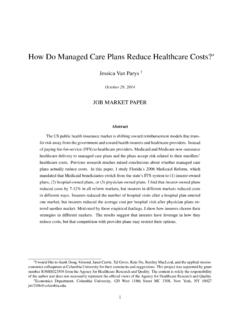Transcription of Understanding the U.S. Healthcare System
1 1. CHAPTER. Understanding the Healthcare System INTRODUCT IO N. The long-term success and prosperity of an organization is inextricably linked to the strategy it pursues over time. A firm Understanding of the environment within which the organization exists is a critical ingredient in the strategy devel- opment process. This chapter identifies both the stakeholders in the Healthcare System and the environmental forces that are at work and must be taken into account in the formulation of strategy. The dramatic growth in the size and cost of the Healthcare industry in the past few decades has refocused all stakeholders (providers, suppliers, payers, and consumers) on one message: the current trend is not sustainable. In response to this, stakeholders (perhaps excluding consumers) have pursued strategies that would enhance their individual positions in this sector of the economy. Fortu- nately, it would seem that most of these strategies have at their core a common concept: value ( , benefit versus cost) derived from health services provided, consumed, and reimbursed.
2 Analyzing these forces with respect to the value proposition provides guidance to the organization's management with respect to setting of priorities, allocation of resources, and development of strategy. In March 2010, in a rare and historic move, the Congress passed the Patient Protection and Affordable Care Act (PPACA), which was signed into law by President Obama and created significant changes that impact virtually every Healthcare organization. Access and value (as defined by quality of care relative to the cost of care) are recurring themes in the legislation and will be discussed later 1. 2 CH A P T E R 1 UN D E R S T A N D I N G THE H E A L T H C A R E S Y S T E M. in this text as both are directly related to quality. The changes as a result of this legislation permeate the industry and will have a significant impact on payers and providers. Therefore, some of the more prominent components of these changes are discussed in this chapter.
3 GOALS AND OBJECTIVES. This chapter is designed to help the reader develop a firm grasp of the vari- ous components of the Healthcare System and understand the major issues faced by the stakeholders within the System . Along with the next chapter, it serves as a foundation for the strategy development discus- sions presented later in this text. After reading this chapter, the reader should be able to: 1. Categorize and describe the stakeholders in the Healthcare System . 2. Discuss the performance of the Healthcare System . 3. Discuss the differences in performance between the health- care System and an average Healthcare System in the industrialized world. 4. Discuss the major issues faced by the Healthcare System . 5. Discuss the rising costs of care and its major components. 6. Discuss the problem of access and lack of universal Healthcare coverage in the United States. 7. Discuss the highlights of the history of Healthcare reform in the United States.
4 8. Discuss how reforms have addressed some of the performance challenges of the Healthcare System . T HE U .S. H E ALTHC ARE SYSTE M. STRUCTURE. The Healthcare System is a product of decades of growth and matura- tion that too often have led to a variety of deficiencies and serious problems. The responses to these problems, whether they came from the private sector T HE U . S . H EALTHCARE S YSTEM S TRUCTURE 3. or the government, have frequently been only short-term corrections. This shortsightedness in addressing the Healthcare System 's problems is a product of the preoccupation of most businesses with short-term financial performance at the expense of thoughtful and responsible course correction and the preoccupa- tion of politicians with political gamesmanship and elections. As a result, the System is a complex of layered adjustments made up mostly of patchwork and temporary fixes to such an extent that any intelligent design is undetectable.
5 This short-term thinking and the unintended consequences of legislated poli- cies have created a complex Healthcare System that is inefficient and difficult to understand. At the core of any Healthcare System , including the Healthcare System , a product or service is offered to a consumer at a certain price. The rules that govern such transactions come from various entities, but all are expected to com- ply with the laws of their country in this case, the United States. As such, one can categorize the major stakeholders as regulators and policy makers, payers, advocacy organizations, providers, suppliers, and consumers. These are broad categories that at times overlap, such that one entity may have more than one role; for example, a consumer may also be the payer. These will be discussed in more detail in the paragraphs that follow. Regulators and Policy Makers in the Healthcare System At the top of the pyramid, the federal government sets the tone for the entire System .
6 Many other entities have been formed over the years in response to the need for control over various areas of the Healthcare industry. Today, the most influential regulators include the Department of Health and Human Ser- vices (HHS), the Centers for Medicare & Medicaid Services (CMS), the Food and Drug Administration (FDA), and the Centers for Disease Control and Pre- vention (CDC). These entities have been charged to interpret, implement, and ensure compliance with the current laws of the United States that affect and govern the Healthcare industry. The scope of regulatory influence of these entities is determined by the laws they enforce. At the state level, state legislatures, state and local governments, health departments, state medical boards, and state insurance commissions also play significant roles while functioning within federal regulations. Nevertheless, state governments have been successful in introducing unprecedented moves that go beyond federal mandates for Healthcare policy; for example, Mas- sachusetts was able to mandate health insurance coverage for all its citizens in 4 CH A P T E R 1 UN D E R S T A N D I N G THE H E A L T H C A R E S Y S T E M.
7 Payers in the Healthcare System Financing in the Healthcare System can be broken down into payments made by the public sector (the federal government, state and local governments), the private sector (private insurers and businesses), and the consumer (out-of-pocket expenses and self-pay). The share of each source in the total national Healthcare expenditure in 2008 is shown in Figure 1-1. As can be seen in the chart, 47% of the expenditure comes from public sources and 53% from private sources. Public funding of the Healthcare System includes federal sources, such as Medicare and Medicaid programs, the Veterans Administration, and the Department of Defense, and state and local programs, such as Medicaid and state and local hospitals. Private funding includes out-of-pocket expenditure, private insurance, and philanthropy. As can be inferred from this list, many of these payers have other capacities and exert substantial influence in other areas of the Healthcare System through pol- icy making ( , CMS) or through advocacy groups and lobbying ( , private insurance companies).
8 Advocacy Organizations This category encompasses organized efforts of smaller entities in the Healthcare System around a common interest that is frequently self-serving. These orga- nizations are numerous, and discussion of their role and influence in the $328B $300B Out-of-Pocket 12% 12%. Private Insurance $401B. 15%. Other Private $849B Medicare 33%. Medicaid $525B. 20%. Other Public $192B. 7%. FIGURE 1-1. In 2010, the total national Healthcare expenditure was $2,594 billion. The breakdown of where this money came from is presented in this chart. B, billion. Data from CMS. 2. T HE U . S . H EALTHCARE S YSTEM S TRUCTURE 5. Healthcare System is beyond the scope of this text. Examples of these groups include the American Medical Association (AMA), the American Society of Clinical Oncology (ASCO), the American Hospital Association (AHA), the American Nurses Association (ANA), America's Health Insurance Plans (AHIP), and the National Patient Advocate Foundation (NPAF).
9 Providers in the Healthcare System This category includes all individuals and organizations that provide a Healthcare service to the consumer. As such, it includes health practitioners, hospitals, nurs- ing homes, and other similar entities. Although health professionals are central to the specific entity that actually provides care, hospitals, in particular, offer the environment in which care can be provided and are compensated by payers for the services provided. It is in the hospital setting that a substantial portion of Healthcare resources are consumed. Individual practitioners, practice groups, general hospitals, specialty hospitals, ambulatory facilities (surgery, imaging, etc.), and integrated Healthcare systems are also examples of providers. Suppliers This category includes pharmaceutical companies and medical equipment companies. These entities have grown to be a significant part of the Healthcare System and are in fact considered industries of their own.
10 Although suppliers are integral to the Healthcare System , the nature of their business is different. Like private insurance companies, most of these organizations are for-profit and publicly traded companies and exist in a different competitive environment. Unlike the payer category, the amount of not-for-profit activity in this category is small. Consumers People, whether sick or healthy, are consumers of care. In the industrialized world, one would be hard pressed to find anyone who has never received any care within a Healthcare System . Consumers of Healthcare services are somewhat dif- ferent from consumers in other sectors of the economy. Two primary differences are (1) Healthcare consumers often have to depend on the advice of a physician in making a health services consumption decision, and (2) in most instances, the consumer is unaware of the full costs of his or her choice because of the interme- diary function of payers even though there may be a significant out-of-pocket component of the full cost.



















